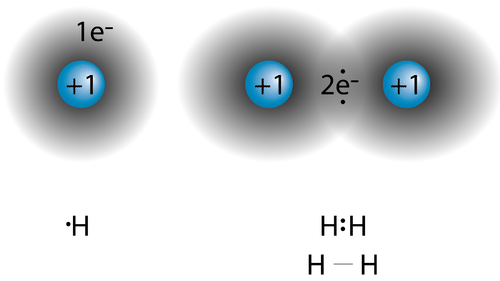19.20: Lewis Electron-Dot Structures
( \newcommand{\kernel}{\mathrm{null}\,}\)
What does cholesterol really look like?
We can write the structure of the cholesterol molecule a couple of different ways. The simplest approach is to simply write C27H46O. This "structure" is not very useful because it does not tell us how the carbons, hydrogens, and oxygen are connected to one another. The structure in the figure above is much more helpful—we see how the different atoms are connected together to form the molecule.
Lewis Electron-Dot Structures
In a previous chapter, you learned that the valence electrons of an atom can be shown in a simple way with an electron dot diagram. A hydrogen atom is shown as H⋅ because of its one valence electron. The structures of molecules that are held together by covalent bonds can be diagrammed by Lewis electron-dot structures. The hydrogen molecule is shown in the figure below.
 Figure 19.20.2: On the left is a single hydrogen atom with one electron. On the right is an H2 molecule showing the electron cloud overlap. (CC BY-NC 3.0; Jodi So via CK-12 Foundation)
Figure 19.20.2: On the left is a single hydrogen atom with one electron. On the right is an H2 molecule showing the electron cloud overlap. (CC BY-NC 3.0; Jodi So via CK-12 Foundation)
The shared pair of electrons is shown as two dots in between the two H symbols (H:H). This is called a single covalent bond, when two atoms are joined by the sharing of one pair of electrons. The single covalent bond can also be shown by a dash in between the two symbols (H−H). A structural formula is a formula that shows the arrangement of atoms in a molecule and represents covalent bonds between atoms by dashes.
The Octet Rule and Covalent Bonds
When ions form, they conform to the octet rule by either losing or gaining electrons in order to achieve the electron configuration of the nearest noble gas. In a similar way, nonmetal atoms share electrons in the formation of a covalent bond in such a way that each of the atoms involved in the bond can attain a noble-gas electron configuration. The shared electrons are "counted" for each of the atoms involved in the sharing. For hydrogen (H2), the shared pair of electrons means that each of the atoms is able to attain the electron configuration of helium, the noble gas with two electrons. For atoms other than hydrogen, the sharing of electrons will usually provide each of the atoms with eight valence electrons.
Summary
- Lewis electron-dot structures show the bonding in covalent molecules.
- Covalent bonds between atoms can be indicated either with dots (:) or a dash (−).
Review
What is a sin gle covalent bond?- How can covalently-bound atoms obey the octet rule?
- Does the hydrogen molecule obey the octet rule?



